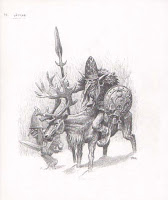Humanoids, Part II: Trolls

This is a followup to Giving Humanoids a Raison d'être , where I cover the Goblins Bugbears, Ogres and trolls. Or simply: Trolls. Let's throw in hill giants, ogre magi (Onis) and hags for good measure. The humanoids discussed in the previous entry were, in a sense, write-ups of Gygaxian Naturalist critters. In this article, the remaining ones will be those of a decidedly more mythic bend. I've compiled them all under the label: Trolls. I've never loved the D&D troll. As a critter, it is a fine piece of work. Everybody fears and loathes regeneration. But trolls, at least as a Scandinavian, has unavoidable mythic connotations to me that Poul Anderson's strange concoction does not meet in any shape or form. The D&D 'troll' is wonderful Chaos Beast no doubt, but it is not mythic. And trolls are mythic. Instead, I've stripped the D&D troll of its rank and title and assigned it to some others critters of mythic origin who could really



